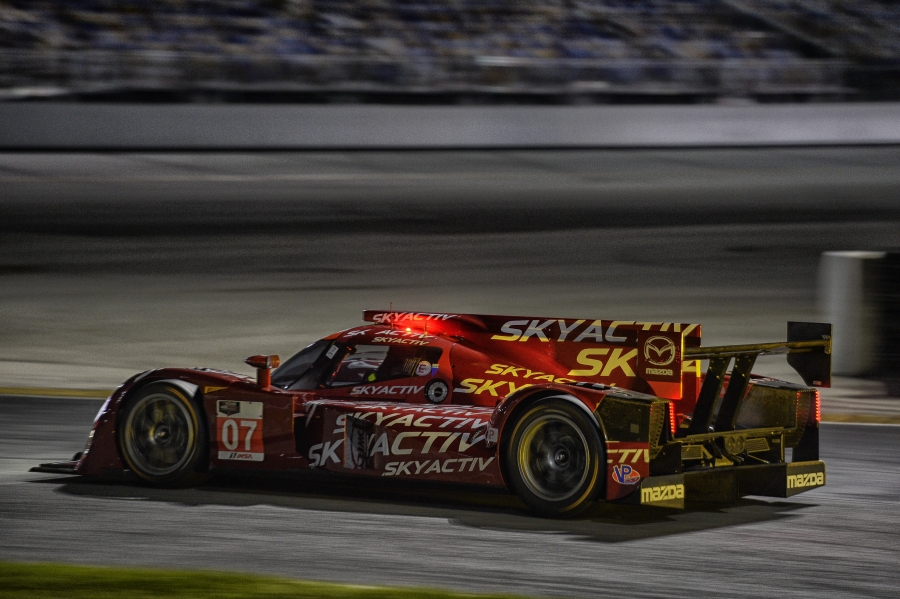ACO, IMSA Continue to Work Towards Common Prototype Regs for 2017
 |
| SKYACTIV Nissan |
While a mix of prototypes from GRAND-AM and the ALMS led the field in last weekend’s Rolex 24 at Daytona, the twice-around-the-clock endurance classic could have an entirely different look to it in just under three years’ time.
The TUDOR United SportsCar Championship season-opener served as the site for additional meetings between the ACO and IMSA, with a host of executives and technical leaders on hand for the historic first round of the North American series.
The two sanctioning bodies announced last September plans to develop a new worldwide prototype platform together for 2017 that would effectively replace the current LMP2 formula.
“We’re working on a new car specification for 2017," said Scot Elkins, IMSA’s VP of competition and technical regulations. “If it’s called P2 and if that’s the P2 platform for the ACO, that’s fine. If it’s the top class here and it’s called Prototype, and it’s the same car, that’s really no different than we have now. We have to work together to see where that goes."
ACO President Pierre Fillon and FIA WEC CEO Gerard Neveu, as well as technical steward Daniel Pedrix were among the representatives on hand at Daytona, as discussions continued over the shape of the proposed 2017 prototype class.
Current LMP2 regulations are locked in through 2016, along with the eligibility of Daytona Prototypes in the TUDOR Championship. What happens beyond that is still being worked out, although it’s believed to be leaning in the direction of an evolved P2 platform, with no carry over from existing DP machinery.
“The ACO has proposed specifications," Fillon told Endurance-Info. “There are many similarities, some differences but no blocking point. It’s too early to reveal the outline. The main idea is to continue with the spirit of the current LMP2 [formula] while reducing costs compared to the LMP2 that we already have."
IMSA’s Elkins, meanwhile, hasn’t ruled out the potential for an evolved approach for the chassis and crash structures currently used in LMP2 cars.
While he confirmed tube-framed cars such as DPs will not be part of the new formula, Elkins admitted they’re intrigued by DTM’s safety cells, which features a carbon fiber tub with a roll cage.
The platform, which debuted in 2012, effectively melds together safety components currently featured in P2 and DP cars.
“I think carbon has to be involved in terms of a monocoque chassis," Elkins said. “I’m intrigued, and I think our group is intrigued by what the DTM has done, which is a safety cell with a roll cage.
“I’m not saying that’s what we’re looking at but I think those guys have done a really interesting approach to specifying a car, allowing each [manufacturer] to build it and do things like that.
“We’ve got a relationship with those guys and it’s something that’s very interesting. I don’t know if that’s the direction, but I know that it won’t be a tube-framed car."
It appears that some LMP2 manufacturers would not be in favor of a radical change in the formula, however, particularly those who have planned for new cost-capped prototype coupes to debut later this year or in 2015.
“As both OnRoak and ORECA have made commitments to produce new cars, you’re not going to want to do that just for two years," HPD technical director Roger Griffiths told Sportscar365. “I could see that perhaps the spine of the car, the basic safety cell and transmission package and suspension, would continue forward.
“I’m sure there will be updates for safety. Maybe they would standardize on a slightly narrower car, like the LMP1 regulations. But I’m hoping they look for some stability towards 2020, we could see the same concept with LMP2.
“If you produce the car for 2015/2016, that basic framework would continue for many years to come. Certainly if we want to be racing at places like Le Mans, we’d have to produce a FIA-certified car, so that leads you down the path of a carbon monocoque and the rest of it. That would be a direction we’d advocate the ACO and FIA to look at strongly."
No specific timeframe has been laid out by either party on the finalization of the new platform, which would run below the LMP1 class in the FIA WEC and at the 24 Hours of Le Mans.
Changes are also in the works for the production-based classes, with GT Convergence meetings continuing in the run-up to a potential announcement of a new worldwide GT platform for as early as 2016.
If both concepts materialize, and IMSA also adopts the new-for-2015 LMP3 formula, it could eventually result in the entire TUDOR Championship field featuring ACO compliant machinery. sportscar365
